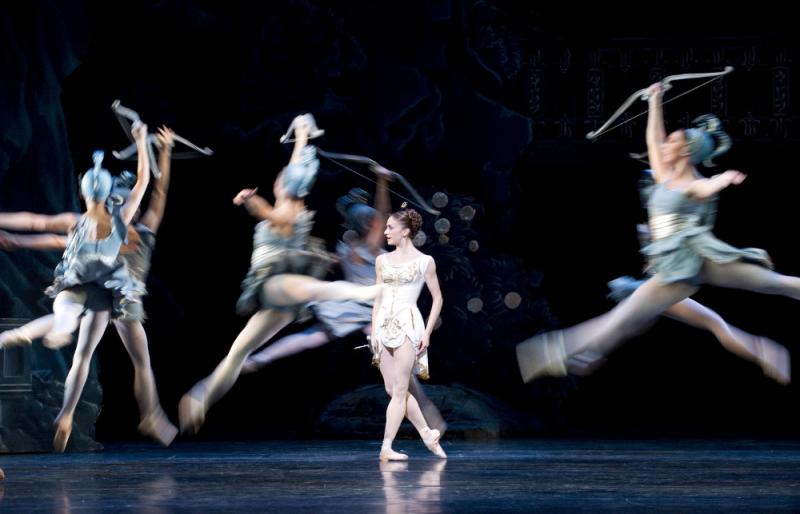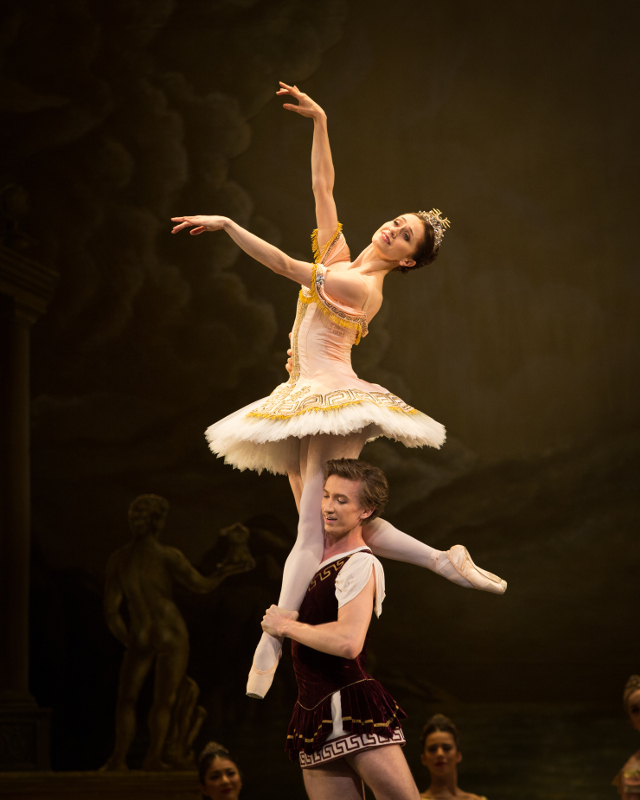Sylvia, Royal Ballet review - Ashton rarity makes a delicious evening | reviews, news & interviews
Sylvia, Royal Ballet review - Ashton rarity makes a delicious evening
Sylvia, Royal Ballet review - Ashton rarity makes a delicious evening
Marianela Nuñez and Vadim Muntagirov sparkle as arcadian lovers

On paper, the appeal of a Sylvia revival is questionable. If even the choreographer (Frederick Ashton) wasn't sure his 1952 original was worth saving for posterity, do we really want to watch a 2004 reconstruction posthumously pieced together from rehearsal tapes?
Sylvia's appeal is enormously boosted by its Delibes score, which is richly colourful and melodic: a delight to the ears all the more potent for being much less frequently heard than many far inferior ballet scores. Hamburg Ballet's conductor Paul Hewett gave a thoroughly engaging account of it with the ROH orchestra last night, not afraid to lean in to the full emotional and dramatic range of the music, but astute enough to hold back from bombast and melodrama. No matter how daft the action on stage is at any given moment, the ever-fresh, stylish merriment of the score redeems it.

With this ardently romantic spirit giving life to the story, one can smile on as the plot and the choreography loop around in swirls of baroque extravangance, complete with naiads, dryads, sylvans, fauns and peasants, oh my... Set and costumes (originally by Christopher and Robin Ironside; updated by Peter Farmer) continually verge on the hopelessly camp, and tip over where the villain of the piece, Orion (Thiago Soares), is concerned. He is presented as a glowering, bearded Turk with an enormous spear (wink, wink) and – compounding orientalism with crimes against fashion – lilac velour harem pants. Poor Soares can do little with this hammy part but grin and bear it.

The choreography is unmistakeably Ashton in its preocupation with fluttery petit allegro and fussy changes of direction. On Nuñez, Muntagirov (pictured above left), Zuchetti and a handful of other dancers (Itziar Mendizabal as Diana, James Hay as a goat, David Yudes as a slave, Fumi Kaneko as Terpsichore) the Ashton style is a balletomane's nerdy delight of frou-frou technicality, and makes an engaging contrast to Russian grandiosity we see in Sylvia's dotty, 19th century ballet relations like Le Corsaire. But unfortunately the choreography gravely challenged many supporting dancers, who not only struggle to convey the Asthon style in port de bras and épaulement (some, like Tierney Heap, don't seem to know where to begin), but look permanently at risk of dropping out altogether. This is a real shame, for not only does it mar an otherwise thoroughly engaging production, but it is rather a poor show if even the Royal Ballet, Ashton's home company, cannot train its dancers to execute his choreography properly.
Focus not on the naiads, dryads, sylvans, fauns, muses et al, then, but on a charming love story, an arcadian setting, and that utterly lovely score. Gritty realism it ain't, but it sure is a delicious evening at the theatre.
- The Royal Ballet perform Sylvia at the Royal Opera House to 16 December
- Read more dance articles on theartsdesk
rating
Share this article
Add comment
The future of Arts Journalism
You can stop theartsdesk.com closing!
We urgently need financing to survive. Our fundraising drive has thus far raised £49,000 but we need to reach £100,000 or we will be forced to close. Please contribute here: https://gofund.me/c3f6033d
And if you can forward this information to anyone who might assist, we’d be grateful.

Subscribe to theartsdesk.com
Thank you for continuing to read our work on theartsdesk.com. For unlimited access to every article in its entirety, including our archive of more than 15,000 pieces, we're asking for £5 per month or £40 per year. We feel it's a very good deal, and hope you do too.
To take a subscription now simply click here.
And if you're looking for that extra gift for a friend or family member, why not treat them to a theartsdesk.com gift subscription?
more Dance
 'We are bowled over!' Thank you for your messages of love and support
Much-appreciated words of commendation from readers and the cultural community
'We are bowled over!' Thank you for your messages of love and support
Much-appreciated words of commendation from readers and the cultural community
 R:Evolution, English National Ballet, Sadler's Wells review - a vibrant survey of ballet in four acts
ENB set the bar high with this mixed bill, but they meet its challenges thrillingly
R:Evolution, English National Ballet, Sadler's Wells review - a vibrant survey of ballet in four acts
ENB set the bar high with this mixed bill, but they meet its challenges thrillingly
 Like Water for Chocolate, Royal Ballet review - splendid dancing and sets, but there's too much plot
Christopher Wheeldon's version looks great but is too muddling to connect with fully
Like Water for Chocolate, Royal Ballet review - splendid dancing and sets, but there's too much plot
Christopher Wheeldon's version looks great but is too muddling to connect with fully
 iD-Reloaded, Cirque Éloize, Marlowe Theatre, Canterbury review - attitude, energy and invention
A riotous blend of urban dance music, hip hop and contemporary circus
iD-Reloaded, Cirque Éloize, Marlowe Theatre, Canterbury review - attitude, energy and invention
A riotous blend of urban dance music, hip hop and contemporary circus
 How to be a Dancer in 72,000 Easy Lessons, Teaċ Daṁsa review - a riveting account of a life in dance
Michael Keegan-Dolan's unique hybrid of physical theatre and comic monologue
How to be a Dancer in 72,000 Easy Lessons, Teaċ Daṁsa review - a riveting account of a life in dance
Michael Keegan-Dolan's unique hybrid of physical theatre and comic monologue
 A Single Man, Linbury Theatre review - an anatomy of melancholy, with breaks in the clouds
Ed Watson and Jonathan Goddard are extraordinary in Jonathan Watkins' dance theatre adaptation of Isherwood's novel
A Single Man, Linbury Theatre review - an anatomy of melancholy, with breaks in the clouds
Ed Watson and Jonathan Goddard are extraordinary in Jonathan Watkins' dance theatre adaptation of Isherwood's novel
 Peaky Blinders: The Redemption of Thomas Shelby, Rambert, Sadler's Wells review - exciting dancing, if you can see it
Six TV series reduced to 100 minutes' dance time doesn't quite compute
Peaky Blinders: The Redemption of Thomas Shelby, Rambert, Sadler's Wells review - exciting dancing, if you can see it
Six TV series reduced to 100 minutes' dance time doesn't quite compute
 Giselle, National Ballet of Japan review - return of a classic, refreshed and impeccably danced
First visit by Miyako Yoshida's company leaves you wanting more
Giselle, National Ballet of Japan review - return of a classic, refreshed and impeccably danced
First visit by Miyako Yoshida's company leaves you wanting more
 Quadrophenia, Sadler's Wells review - missed opportunity to give new stage life to a Who classic
The brilliant cast need a tighter score and a stronger narrative
Quadrophenia, Sadler's Wells review - missed opportunity to give new stage life to a Who classic
The brilliant cast need a tighter score and a stronger narrative
 The Midnight Bell, Sadler's Wells review - a first reprise for one of Matthew Bourne's most compelling shows to date
The after-hours lives of the sad and lonely are drawn with compassion, originality and skill
The Midnight Bell, Sadler's Wells review - a first reprise for one of Matthew Bourne's most compelling shows to date
The after-hours lives of the sad and lonely are drawn with compassion, originality and skill
 Ballet to Broadway: Wheeldon Works, Royal Ballet review - the impressive range and reach of Christopher Wheeldon's craft
The title says it: as dancemaker, as creative magnet, the man clearly works his socks off
Ballet to Broadway: Wheeldon Works, Royal Ballet review - the impressive range and reach of Christopher Wheeldon's craft
The title says it: as dancemaker, as creative magnet, the man clearly works his socks off
 The Forsythe Programme, English National Ballet review - brains, beauty and bravura
Once again the veteran choreographer and maverick William Forsythe raises ENB's game
The Forsythe Programme, English National Ballet review - brains, beauty and bravura
Once again the veteran choreographer and maverick William Forsythe raises ENB's game

Comments
Totally agree. I was there
Even if it’s a review -
Is it? It might also help a
What Dr. Weibye has to say